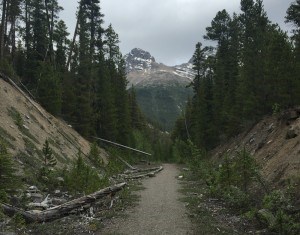
The federal NDP is the latest group to criticize a $65.9-million proposal to build a paved multi-use trail from Jasper to the Columbia Icefield.
On July 13, NDP national parks critic Wayne Stetski called on the federal government to release the full details of the plan and to undertake thorough public consultations.
“The new government promised Canadians more transparency, but there has been no public consultation, no needs assessment and no environmental assessment done on this project,” said Stetski in a press release.
In a follow up interview, he described the proposed project as “putting the cart before the horse.”
“Sixty-six million dollars is a fair chunk of money particularly given what’s happened to Parks Canada’s budgets over the last 10 years,” said Stetski, referring to the budget cuts and mass layoffs under the former Conservative government.
He questioned whether the money would be better spent improving Parks Canada’s ecological and science capacity.
The Association for Mountain Parks Protection & Enjoyment (AMPEE) welcomed the proposed trail and took the time to remind Canadians the project will still have to undergo an environmental assessment and public consultations before it’s approved.
“When money is earmarked it doesn’t mean a project is given a green light, it’s simply not true,” said Casey Peirce, the executive director for AMPEE.
“Canadians need to know that new opportunities like this are by no means a go before they undergo environmental impact studies and thankfully we have an organization in place, which is Parks Canada, to make sure any new project is done responsibly.”
According to Parks Canada, the 107 km multi-use trail will parallel the Icefields Parkway and make use of areas that have already been disturbed, such as the old highway. It will eventually stretch to Lake Louise where it will link up with a current bike trail along the Trans Canada highway. The targeted completion date for the trail is March 2019.
“In 2016-2017, Parks Canada will undertake project planning and design, which includes engaging stakeholders, undertaking detailed impact analysis and completing detailed designs and construction specifications,” wrote Steve Young, a communications officer for Jasper National Park.
“Over the course of the summer and throughout the planning phase, Parks Canada will undertake the necessary analysis and engage with local communities and Indigenous groups on the development and planning for this project.”
Parks Canada has previously stated the trail would have no net ecological or cultural impact on the park.
Many advocates for the project have compared the proposed trail to the Legacy Trail between Canmore and Banff.
“The Legacy Trail between Canmore and Banff has been an unprecedented success and certainly in its development there was controversy as well, but I can’t tell you how successful it’s been,” said Peirce.
The NDP’s criticism of the proposed trail comes nearly three weeks after a coalition of environmental groups called on the government to cancel the project, pointing to it as the latest example of a project that was developed behind closed doors without any public input.
One of the groups leading the charge is the Canadian Parks and Wilderness Society (CPAWS), which reiterated its call to halt the proposed trail in its annual report published earlier this month.
The report also included 17 other recommendations to limit development in Canada’s national parks.
Among the recommendations, CPAWS would like the minster of environment and climate change to not only halt the proposed bike trail, but use the money for ecological monitoring and conservation efforts.
“We’ve seen an alarming trend over the last 10 years towards management of our national parks for revenue generation and not for nature conservation, which is supposed to be the number one priority of the management of our national parks,” said Alison Ronson, executive director for the northern chapter of CPAWS.
According to the report, Parks Canada spent $202 million on visitor experience last year, more than double the amount spent on conservation efforts.
“In 2012 the previous government significantly cut Parks Canada’s budget and a lot of that was from the science and conservation branches so what we would like to see is a return to a time when Parks Canada was given the proper resources to do their scientific and conservation job,” said Ronson.
One of the recommendations put forward to the minister was restoring $25 million per year in funding for science-based management programs.
The environmental organization would also like the minister to cancel the Maligne Lake development proposal, which was conceptually approved by Parks Canada in 2014, before getting caught up in a legal dispute.
In a nod to the legal challenge, which was ultimately dismissed by a federal court judge, CPAWS would like the minister to make it a legal requirement for management plans to be reviewed every five years, instead of 10.
“When we were fighting the legal challenge against the tent cabins at Maligne Lake one of the concerns was that there was this potential attempt to unilaterally amend the management plan based on a commercial proposal,” explained Ronson.
“If you’re reviewing the management plan every five years, rather than 10 it keeps things fresh in the minds of the public and in the minds of Parks Canada about why the management plan was drafted the way it was.”
She acknowledged that opening up the management plan every five years could also open the door to looser environmental restrictions and possibly allow even more development.
“We’d like to see the managers of these wilderness areas reaffirm their commitment to managing our parks the way their legally suppose to be managed, which is with nature as the number one priority,” said Ronson.
Paul Clarke
[email protected]
